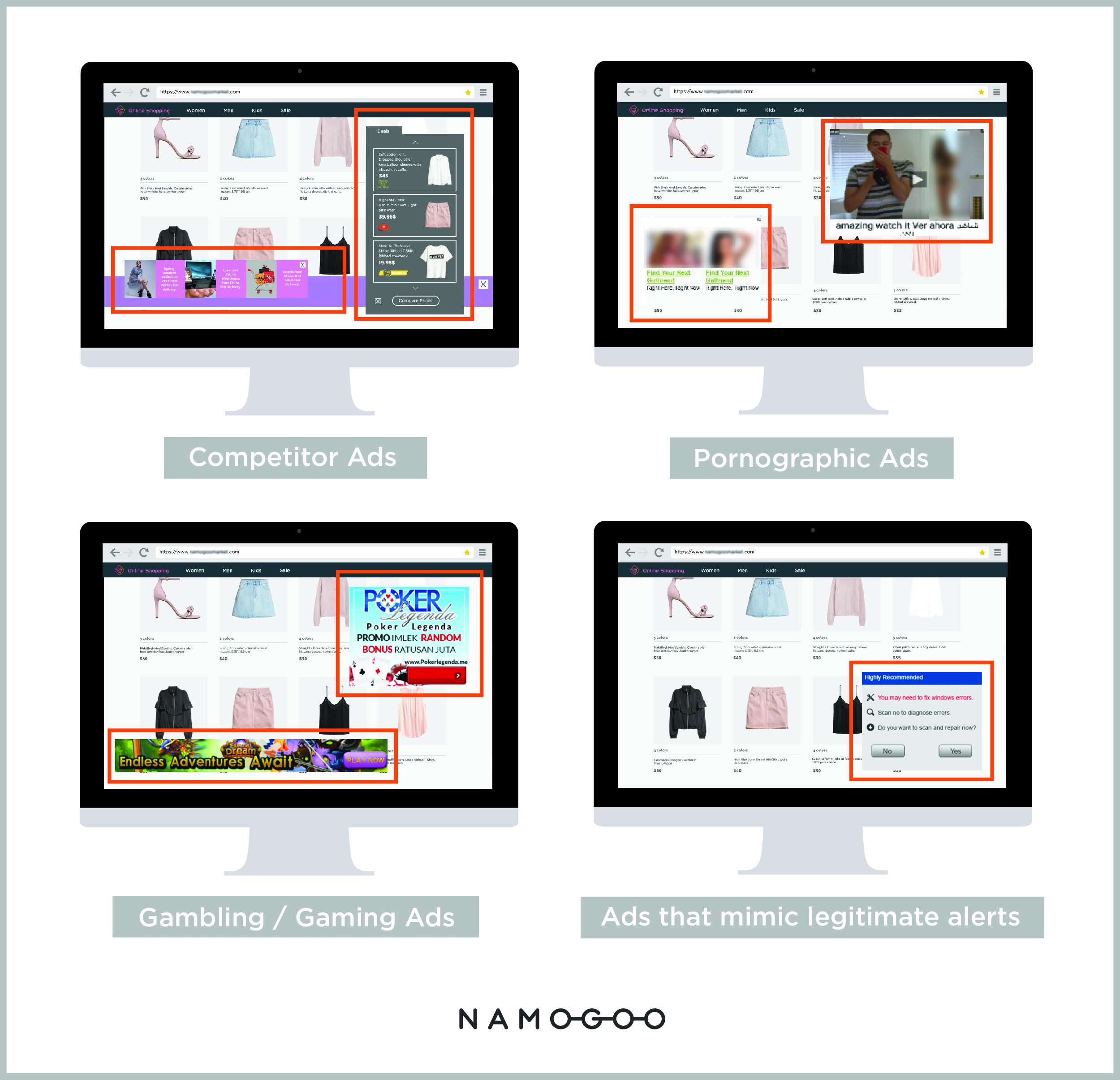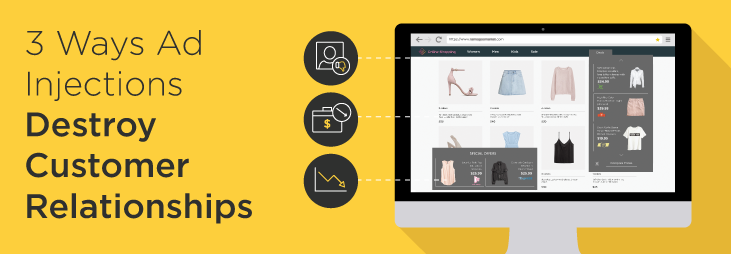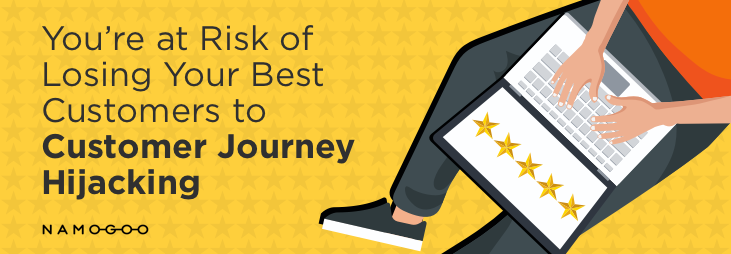With businesses becoming increasingly aware of Customer Journey Hijacking (CJH) and the ways it can hurt a company’s bottom line, it’s tempting to think of ad injections as a problem that primarily affects customers’ shopping decisions in the short term. But there’s another side to CJH that’s no less important: The numbers show that it has the potential to do serious damage to long-term customer relationships.
How does CJH work? First, a consumer’s browser or device is infiltrated by ad injections, that typically are either bundled secretly with free software (such as a browser extension or mobile app) or installed discreetly via an unsecured Wi-Fi network. Second, the injected adware tracks the user’s activities to build a personal profile reflecting their preferences and habits. Third, when the user visits an online store, the ad injections them with ads designed to look like they are part of the store’s website.
Those ad injections are quite effective. They typically target between 15% and 25% of online shoppers (with higher numbers during peak periods such as the holiday shopping season), reducing retailers’ overall conversion rates by between 2% and 5%. That results in a drop in revenue per visitor of between 5% and 7%.
But in the long run, CJH can do even more harm by undermining and preventing customer loyalty. Here are three of the main ways ad injections can ruin customer relationships:
#1: Leading customers to buy from competitors
The most common way that Customer Journey Hijacking hurts customer relationships is by guiding your website’s visitors straight into the arms of your competitors. At Namogoo, we have found that promotions for products offered by competing stores account for 60-65% of the injected ads that target customers of the retailers we work with.
And when a customer is tempted by an injected ad, there’s a real chance that shopper could disappear forever. In fact, in our survey of more than 1,300 online shoppers, 58% of respondents said that if they were shopping in an online store when they saw a pop-up ad for a competitor selling the same product at a lower price, they would likely click the ad. And 80% said that if they ended up buying from the competing store instead of the first store in this scenario, the competing store is the one they would be more likely to visit the next time they are looking for a similar product.
In other words, the majority of ad injections pose a threat to online stores by promoting their competitors – and when you lose a sale to CJH, you may well be losing a customer for good.
#2: Scaring shoppers away
If you think ads leading to your competitors are harmful, think of the damage that could be done to your brand reputation by the other 35-40% of ad injections.
Of the injected ads that we at Namogoo have identified and blocked, we have found that:
- 10% promote adult websites.
- 15-20% promote online gambling or gaming.
- 5-10% are designed to mimic legitimate alerts (such as error messages or recommendations from the user’s operating system) in order to trick users into clicking on them.
Worse yet, consumers who view ad injections while visiting a website typically think these ads are coming directly from the site, rather than running on their own digital devices. As a result, if a shopper is in your online store when an injected ad appears, they are likely to blame your company.
In fact, in our study of online shoppers, 78% of respondents said that if they were exposed to an injected ad while shopping on an eCommerce site, they would view that retailer negatively because of this interaction. This study also found that 66% of consumers think that if they are visiting an eCommerce website when pop-ups, banner ads, and product ads appear, that indicates that their privacy is being compromised. And perhaps most shockingly, only 3% of consumers said that if they are visiting an eCommerce site when a pop-up for a competitor appears, that is a result of a bug on their own device rather than a problem caused by the website.
Taken together, those numbers paint a stark picture of the damage that Customer Journey Hijacking could cause to your brand reputation and customer relationships.
Examples of Ad Injections

#3: Making customers wait
Having to wait a number of seconds for a website to load may sound less shocking than viewing inappropriate content or ads for competing products, but slowly loading web pages pose a costly problem for retailers. Considering the mindset of online shoppers – consumers who may be choosing eCommerce specifically because of its speed and efficiency – it’s not hard to imagine how slow page loading could damage the customer experience.
How big of an impact can an eCommerce website’s speed have on its bottom line? According to a 2017 study by Google and SOASTA, slowing a website’s loading time by one second on mobile devices can lower conversion rates by up to 20%.
By requiring web browsers to process and transmit more information, injected ads can make webpages take longer to load. In some cases, CJH can even cause a website to freeze or crash – a customer experience catastrophe. And 3% of ad injections feature videos, increasing the chances of slow loading, freezing, and crashing.
As a result, even if your customers aren’t clicking to be redirected to your competitors, and even if they’re not offended by the injected ads they see when they visit your website, a frustratingly slow customer experience could slam the door shut on a sale (and on a customer relationship).
How Customer Journey Hijacking hurts retailers in the long run
Part of the problem with CJH is that it sabotages eCommerce sales through a combination of “push” and “pull” factors. While ads for similar products at lower prices could pull a shopper into a competing store, offensive ads and slow page loading times can push consumers away.
Not only does this combination of factors hurt online sales, but it can wreak havoc on customer relationships. Considering the cost of acquiring a new customer and the fact that repeat customers tend to spend more, the damage caused by injected ads can be both significant and irreversible.
And when we factor in the realization that ad injections disproportionately target users who are more active online shoppers, it’s not hard to see how damaging CJH can be to an online store in the long run.
How is Customer Journey Hijacking affecting your sales? For a look at what injected ads are doing in your online store, you can get a free website analysis.






